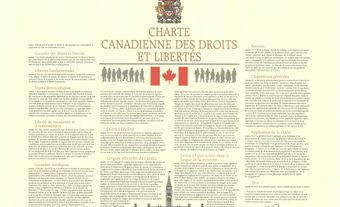The 1217 Charter of the Forest (Carta de Foresta) is a companion document to the Magna Carta of 1215. It set precedents for public access to crown land and for common stewardship of shared resources throughout the English-speaking world, including Canada, that continue to the present day.
Background
In 1215, possibly as much as one-third of the land in England was designated as “forest” areas where the monarch enjoyed a monopoly over all governance and distribution of resources. The 13th-century forest included both sparsely inhabited wooded areas, such as the famous Sherwood Forest, and rural villages where land was developed for agriculture. Prior to Magna Carta and the Charter of the Forest, public use of forest land was subject to extensive and arbitrary regulations which changed during each monarch's reign.
Successive kings treated the enforcement of forest law as a lucrative revenue source, charging fees to forest inhabitants for the right to develop their land in any way, including removing trees, pasturing animals or digging ditches. If the king’s chief forester judged that a villager had violated forest law, he could impose a fine on the entire community. Deer hunting was the king’s prerogative and the penalty for poaching was death or mutilation. Forest boundaries changed frequently as the king declared additional lands as forest or agreed to declassify a region as forest in exchange for a large payment from its inhabitants.
The Charter
Reforming forest governance was a priority for the supporters of Magna Carta. Following the death of King John in 1216, William Marshal, 1st Earl of Pembroke and regent (or adult ruler) for nine-year-old Henry III, issued the Charter of the Forest in 1217. The document defined the “evil customs” described in Magna Carta, and established a new model for managing forest resources.
The charter stated: “Every free man may henceforth without being prosecuted make in his wood or in land he has in his forest, a mill, a preserve, a pond, a marl-pit or a ditch, or arable outside the covert in arable land, on condition that it does not harm any neighbour.” With this clause, responsibility for the stewardship of common resources on forest land shifted from the monarch to the community. The last clause of the charter asserted: “These liberties concerning the forests we have granted to everybody.”
Lasting Impact
The Charter of the Forest set lasting precedents regarding community responsibility for the management and use of shared resources throughout the English-speaking world, including Canada. The charter also set precedents regarding public access to crown land. For example, the the British Columbia Commission on Resources and Environment, established in 1992, produced the Land Use Charter, which encouraged community consensus in the development of crown land.
In the United Kingdom, certain clauses of the charter remained in force until the passing of the 1971 Wild Creatures and Forest Laws Act, which abolished “any prerogative right of Her Majesty to wild creatures (except royal fish and swans), together with any prerogative right to set aside land or water for the breeding, support or taking of wild creatures.” England’s New Forest and Forest of the Dean still maintain special courts for adjudicating forest law as dictated by the nearly 800-year-old Charter of the Forest.

 Share on Facebook
Share on Facebook Share on X
Share on X Share by Email
Share by Email Share on Google Classroom
Share on Google Classroom



